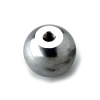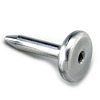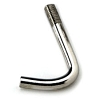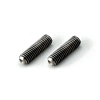|
|||||||||||||||||||||||||||||||||||||||||||||||||||||||||||||||||
MODEL 250 |
FEATURES |
||||||||||||||||||||||||||||||||||||||||||||||||||||||||||||||||
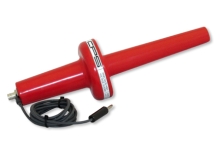 |
Precision 50 kV DC high voltage probe
|
||||||||||||||||||||||||||||||||||||||||||||||||||||||||||||||||
|
DESCRIPTION
Model 250 is a precision, high voltage resistive probe that allows low-level voltmeters to safely and accurately measure DC voltages (only) up to 50 kV. Its unusually short length — only twelve inches — is made possible by our oil-free, state-of-the-art epoxy encapsulation technology. Divider ratios of 1000:1 and 10000:1 are standard, and calibration is traceable to NIST primary standards. Its excellent accuracy, high load impedance, and compact size make it ideally suited for calibrating, monitoring and testing a wide range of high voltage equipment, including HV power supplies, CRT display systems, microwave systems, and nuclear instrumentation. For higher voltage applications, the Model 500 100 kV probe is also available. SafetyThe probe includes an attached grounding cable which, when connected to a suitable ground potential, protects the operator and measurement system from high voltage exposure. A high voltage bell is integrated into the probe body between its handle and high voltage tip to increase the surface path length, effectively increasing the distance between operator and high voltage. Probe tipsA variety of interchangeable probe tips are also available to meet a range of application requirements. The probe end has a threaded opening that allows standard CPS tips as well as custom tips to be easily attached. Two additional threaded openings are provided in the high voltage bell to allow the probe to be securely mounted to a measurement system. Included Accessories
CHOOSING A PROBE
Four standard versions of the model 250 probe are available (see table below). Each model is calibrated to work with voltmeters having a specific input impedance, and will produce an output voltage that is scaled by either 1000:1 (1 V out per kV) or 10000:1 (100 mV out per kV).
Selection process
CalibrationEvery probe is factory calibrated to compensate the input impedance of the voltmeter it will be connected to. Consequently, you must know your meter's input impedance so you can select a probe that has proper compensation. This information can be found in the specifications published by the meter manufacturer. Handheld meters commonly have 10 MΩ input impedance, whereas high quality bench meters may have impedances exceeding 10 GΩ. Note that some meters have a different input impedance for each input range. In such cases, be sure to base your probe choice on the meter range that will be used and, when using the probe, lock the meter range (disable auto-ranging) to ensure the proper input impedance. Use models 250-M-xx with meters that have 10 MΩ input impedance, or models 250-G-xx with meters that have > 10 GΩ impedance (denoted as "open" in probe description). Custom calibrations are also available; contact CPS technical sales if you need to compensate a non-standard meter impedance. Please note that no AC calibration is performed. This probe is not recommended for AC measurement. Alternative digital probesCPS also offers model 255, a digital 50 kV probe. Instead of connecting to a voltmeter via BNC, this digital probe communicates directly with a computer via USB. Model 255 is recommended in cases where a computer is available and a standalone voltmeter is not required. Probe selection is simplified because there are no calibration options, and it can eliminate the need for an expensive, high-accuracy meter. ACCESSORIES
Probe tipsThree standard, interchangeable tips are available:
Protective caseThe probe is a precision instrument that should be protected when not in use. An optional instrument case is available for this purpose: Viewing blockFor applications up to 30 kV, this viewing block provides a convenient way to make a three-way connection between probe, power supply and load: SPECIFICATIONS
* Standard probes are factory calibrated to minimize errors from 10 to 50 kV and then tested to ensure accuracy across the probe's operating range. We can calibrate across a different, custom range upon request, but cannot guarantee specified accuracy across the probe's operating range in such cases. Custom calibration ranges must be specified when ordering. DOWNLOADS
PRICES
|
||||||||||||||||||||||||||||||||||||||||||||||||||||||||||||||||
| CPS | 7313 SW Tech Center Drive | Tigard, OR 97223 | 503.684.8026 | f: 503.684.8164 | E-mail us | |||||||||||||||||||||||||||||||||||||||||||||||||||||||||||||||||



